In a hot market like today, it's easy to ignore Dividend Aristocrats, the elite group of S&P 500 stocks that have raised their dividend every year for at least 25 years. Tech stocks like the FANG group, none of which even offer a dividend, have stolen headlines and delivered monster returns in recent years. But there have been plenty of dividend-paying winners as well.
Even for growth investors, it's a good idea to consider diversifying with some dividend stocks, and there's no better place to look than the list of Dividend Aristocrats, proven and reliable winners for more than a generation. Keep reading to see why these three Motley Fool contributors love Abbott Labs (ABT 1.47%), Johnson & Johnson (JNJ 0.41%), and McDonald's (MCD 0.39%).

Image source: Getty Images.
Innovation could fuel future dividend increases
Todd Campbell (Abbott Labs): Abbott Labs has increased its dividend for 46 consecutive years, and there's good reason to think that the medical device giant's track record won't change anytime soon. The company's latest continuous glucose monitor (CGM) will soon be available in the U.S., and when that happens, it should provide profit tailwinds that support future dividend increases.
The diabetes market is massive. There are over 400 million people with diabetes worldwide, and industry watchers think that figure will increase to over 500 million by 2045.
Currently, CGMs are used mostly by type 1 diabetics to monitor their blood sugar levels to determine appropriate insulin dosing. Type 1 diabetes accounts for less than 5% of the diabetic population in the U.S., but cheaper CGMs could spread their use to tens of millions of people.
Abbott's CGM -- the FreeStyle Libre -- is the lowest-cost CGM on the market. A second-generation version of it is already available in Europe, and it's currently under Food and Drug Administration review for approval in the U.S. Although Libre 2.0 isn't sold in the U.S. yet, rising sales of the Libre 1.0 in the U.S. and strong sales of Libre 2 in Europe are boosting Abbott's financials. In Q1, an 80% year-over-year increase in Libre sales to $380 million caused sales for Abbott's diabetes care segment to increase 40%.
As a massive company, Abbott Labs isn't going to have one product alone make it or break it, but Libre's performance is still noteworthy. It's a big reason Abbott's guiding for sales to increase by at least 6.5% in 2019. And it's a great indication of how innovation may fuel dividend increases beyond today's 1.6% yield in the coming decades.
Operational excellence in the healthcare sector has only one name
Sean Williams (Johnson & Johnson): Although there are nearly five dozen Dividend Aristocrats to choose from in 2019, I spy with my eye only one company among the group with the most pristine credit rating of them all (AAA), even higher than that of the U.S. government. I'm talking about none other than Johnson & Johnson, and its 2.6% dividend yield.
Even though J&J has received some bad press of late concerning legal judgments tied to its talcum baby powder, this represents but a momentary speed bump for a healthcare conglomerate that's mapped a long road of success.
What makes Johnson & Johnson so successful is the company's operational diversity. Each of its three segments brings something to the table that the other segments lack, making J&J the trusted investment it is today.
The consumer health division tends to deliver the weakest long-term growth prospects, but by far the most predictable cash flow. Not to mention, pricing power for consumer health products is relatively strong, leading to slow, but steady, growth.
The medical device segment is a play on the future. While medical devices have been somewhat commoditized in the near term, an aging population of boomers is liable to need an increasing number of spinal, hip, and knee procedures as time goes on. As one of the largest producers of medical devices in the world, J&J is uniquely positioned to take advantage of an aging population and improved global access to medical and preventative care.
Lastly, there's Johnson & Johnson's pharmaceutical segment, which now represents about half its total sales. Brand-name drugs only have a finite runway due to patent expirations. But J&J has built up an impressive-enough portfolio, both organically and through acquisitions and partnerships, that operational growth in its pharma segment has the ability to hit double digits. In fact, pharmaceutical sales are predominantly responsible for helping J&J to its 35th consecutive year of adjusted earnings growth in 2018.
Johnson & Johnson may not offer the flash of a fast-growing biotech stock, but among Dividend Aristocrats, it's truly elite.
Everything you need for an investor happy meal
Jeremy Bowman (McDonald's): There's no question that the way Americans eat has changed a lot over the last generation, but that's done little to deter McDonald's consistent growth. The fast-food giant remains the world's biggest restaurant chain by systemwide sales, and under CEO Steve Easterbrook, the company has a number of initiatives to continue delivering growth.
McDonald's strengths like its well-known brand and prime real estate aren't going anywhere. But Easterbrook has revamped the company by remodeling stores through the company's Experience of the Future program, updating the menu with fresh beef for the Quarter Pounder, expanding value-menu options, and adding all-day breakfast. He's also embraced delivery through a partnership with Uber Eats, and refranchised stores at home and abroad to unlock cash flow.
Last year, comparable-store sales rose 4.5%, including positive growth in all its segments, and EPS jumped 18% to $7.54, with the help of a lower tax rate. McDonald's also raised its dividend by 15% to $1.16 each quarter, good for a yield of 2.4% today with shares at an all-time high. Its payout ratio is also reasonable at 62% based on last year's EPS, giving the company plenty of room to continue lifting its dividend.
McDonald's business, operating fast-food restaurants, is timeless. And the company's global brand gives it an advantage over challengers around the world. As it continues to modernize its stores and its menu, the company's performance should improve, and investors will reap the benefits both in share price appreciation and dividend growth.








